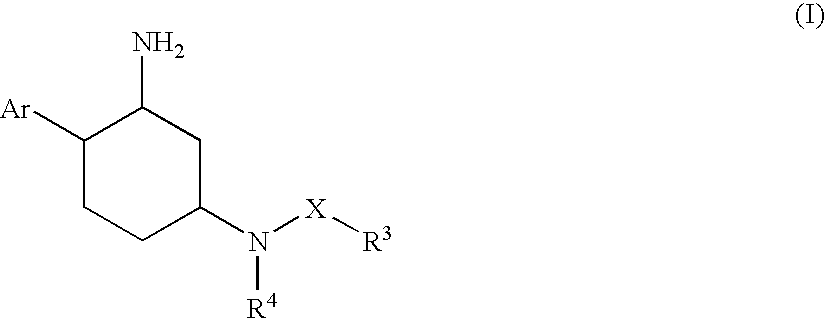Aminocyclohexanes as Dipeptidyl Peptidase-Iv Inhibitors for the Treatment or Prevention of Diabetes
a technology of dipeptidyl peptidase and dipeptidyl peptidase, which is applied in the field of substituted aminocyclohexanes, can solve the problems of increased and premature morbidity and mortality, increased risk of macrovascular and microvascular complications in patients with type 2 diabetes mellitus, and increased plasma insulin levels
- Summary
- Abstract
- Description
- Claims
- Application Information
AI Technical Summary
Benefits of technology
Problems solved by technology
Method used
Image
Examples
example 1
[0223]
[(1S,2R,5S)-5-[3-(Trifluoromethyl)-5,6,7,8-tetrahydro[1,2,4]triazolo[4,3-α]pyrazin-7-yl]-2-(2,4,5-trifluorophenyl)cyclohexyl]amine, bis trifluoroacetic acid salt
Step A: tert-Butyl [(1S,2R,5S)-5-[3-(trifluoromethyl)-5,6,7,8-tetrahydro-[1,2,4]triazolo[4,3-α]pyrazin-7-yl]-2-(2,4,5-trifluorophenyl)cyclohexyl]carbamate and tert-butyl [(1S,2R,5R)-5-[3-(trifluoromethyl)-5,6,7,8-tetrahydro-[1,2,4]triazolo[4,3-α]pyrazin-7-yl]-2-(2,4,5-trifluorophenyl)cyclohexyl]carbamate
[0224] A solution of tert-butyl [(1S,2R)-5-oxo-2-(2,4,5-trifluorophenyl)cyclohexyl]carbamate (Intermediate 1, 70 mg) and 3-(trifluoromethyl)-5,6,7,8-tetrahydro-1,2,4-triazolo[4,3-α]pyrazine (Intermediate 4, 39 mg) in dichloromethane (5 mL) was treated with titanium tetrachloride (1M in dichloromethane, 0.1 mL). The reaction mixture was stirred at room temperature overnight and then treated with a solution of sodium cyanoborohydride (38 mg) in methanol (2 mL). After stirring for 15 min, the solution was brought to pH...
example 2
[0226]
[(1S,2R,5R)-5-[3-(Trifluoromethyl)-5,6,7,8-tetrahydro[1,2,4]triazolo[4,3-α]pyrazin-7-yl]-2-(2,4,5-trifluorophenyl)cyclohexyl]amine, bis-trifluoroacetic acid salt
[0227] Essentially following the procedure outlined in Example 1, Step B, the faster eluting (1S,2R,5R) isomer from Example 1, Step A was converted to the title compound. 1H NMR (600 MHz, CD3OD): δ 7.35 (m, 1H), 7.16 (m, 1H), 4.28 (m, 2H), 4.04 (d, 1H, J=15.7 Hz), 3.96 (d, 1H, J=15.7 Hz), 3.77 (dt, 1H, J=2.7,11.8 Hz), 3.16 (m, 1H), 3.09 (br, 1H), 3.06 (m, 1H), 2.88 (quintet, 1H, J=3.0 Hz), 2.54 (dq, 1H, J=14.0,2.9 Hz), 2.28 (dm, 1H, J=14.1 Hz), 1.98 (qm, 1H, J=12.4 Hz), 1.78 (ddd, 1H, J=2.6,13.5,14.4 Hz), 1.74 (m, 1H), 1.70 (m, 1H).
[0228] Following essentially the procedures outlined for Example 1, the Examples listed in Table 1 were prepared.
TABLE 1MSExampleR1NR4(XR3)(M + 1)32-F, 5-F402.242-F, 5-F338.152-F, 4-F, 5-F347.162-F, 4-F, 5-F420.172-F, 4-F, 5-F—NMeCH2Ph349.282-F, 4-F, 5-F415.192-F, 4-F, 5-F419.1
example 10
[0229]
[(1S,2R,5S)-5-(5,6-Dihydro[1,2,4]triazolo[1,5-α]pyrazin-7(8H)-yl)-2-(2,4,5-trifluorophenyl)cyclohexyl]amine
[0230] To a solution of tert-butyl [(1S,2R)-5-oxo-2-(2,4,5-trifluorophenyl)cyclohexyl]carbamate (Intermediate 1, 200mg) in anhydrous methanol (8.0 mL) under nitrogen was added 5,6,7,8-tetrahydro[1,2,4]triazolo[1,5-α]pyrazine hydrochloride (55 mg), triethylamine (0.081 mL) and decaborane (22 mg). After stirring at 50° C. for 24 h, the reaction mixture was concentrated and chromatographed by preparative TLC (silica gel, 1:4:95 ammonium hydroxide / methanol / dichloromethane). The slow moving desired compound was recovered, stirred in 4N hydrogen chloride in 1,4-dioxane for 50 min, and concentrated. The residue was purified by preparative TLC (silica, 1:9:90 ammonium hydroxide / methanol / dichloromethane) to afford the title compound. LC-MS 352.1 (M+1).
PUM
| Property | Measurement | Unit |
|---|---|---|
| volume | aaaaa | aaaaa |
| emission wavelength | aaaaa | aaaaa |
| excitation wavelength | aaaaa | aaaaa |
Abstract
Description
Claims
Application Information
 Login to View More
Login to View More - R&D
- Intellectual Property
- Life Sciences
- Materials
- Tech Scout
- Unparalleled Data Quality
- Higher Quality Content
- 60% Fewer Hallucinations
Browse by: Latest US Patents, China's latest patents, Technical Efficacy Thesaurus, Application Domain, Technology Topic, Popular Technical Reports.
© 2025 PatSnap. All rights reserved.Legal|Privacy policy|Modern Slavery Act Transparency Statement|Sitemap|About US| Contact US: help@patsnap.com



